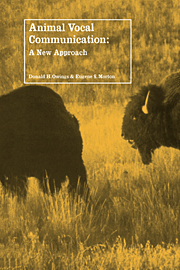Book contents
- Frontmatter
- Contents
- Preface
- Acknowledgments
- Prologue
- 1 Overview of ideas
- 2 The roles of assessment and management in communication
- 3 Form and function in vocal communication
- 4 Mechanisms and proximate processes of vocal communication
- 5 Assessment/management: a viable replacement for the information concept
- Reference
- Index
3 - Form and function in vocal communication
Published online by Cambridge University Press: 05 June 2012
- Frontmatter
- Contents
- Preface
- Acknowledgments
- Prologue
- 1 Overview of ideas
- 2 The roles of assessment and management in communication
- 3 Form and function in vocal communication
- 4 Mechanisms and proximate processes of vocal communication
- 5 Assessment/management: a viable replacement for the information concept
- Reference
- Index
Summary
Consequences, society, fighting, and the origin of vocal communication
This chapter describes how the consequences of vocalizations have affected their form, i.e., their physical structures. Social consequences of vocalizing result from assessment, but there are other consequences too. If a bird is killed by a predator attracted to its song, the predator's attack is a side-effect, not a social consequence, of singing. Therefore, conspicuous singing, and other communicative behavior, is selected for if, on balance, given side-effects, it results in fitness benefits. Another class of side-effects might accrue during eavesdropping by nontarget individuals (Myrberg, 1981; McGregor & Dabelsteen, 1996). For example, female lions roar to stay in contact with their pridemates and defend their territories against other prides. In doing so, they risk attracting the attention of potentially infanticidal males. Females counteract this eavesdropping by roaring in choruses, which intimidates these males (Grinnell & McComb, 1996). So, both social consequences and side-effects are sources of selection on communication.
Social consequences arise chiefly from assessment. The assessor perceives a signal. It might do nothing, it might run away, it might share, it might copulate, etc. By assessing and acting in its own interest, the assessor provides feedback to the manager to determine what has been accomplished. This process drives the evolution of communication. But what if the assessor does not act in the manager's interest at all? The only road left for the manager is to change the assessor's behavior physically by fighting and this is common enough. And here we have a hint about the possible evolutionary origin of communication - communication substitutes for fighting over resources.
- Type
- Chapter
- Information
- Animal Vocal CommunicationA New Approach, pp. 101 - 160Publisher: Cambridge University PressPrint publication year: 1998



